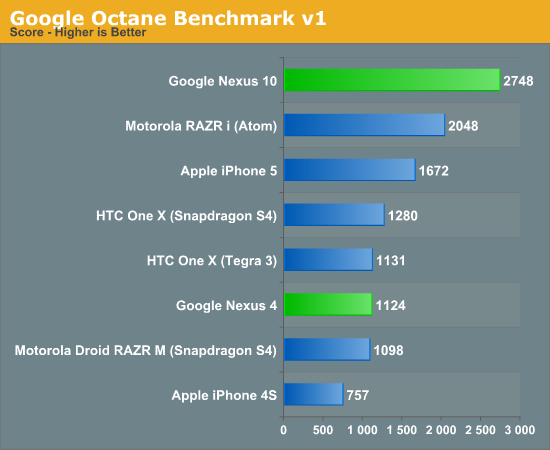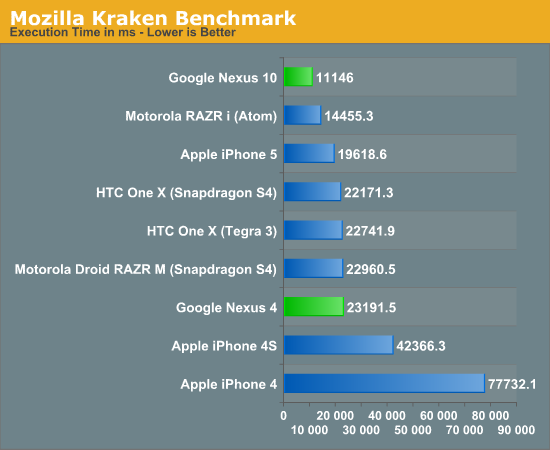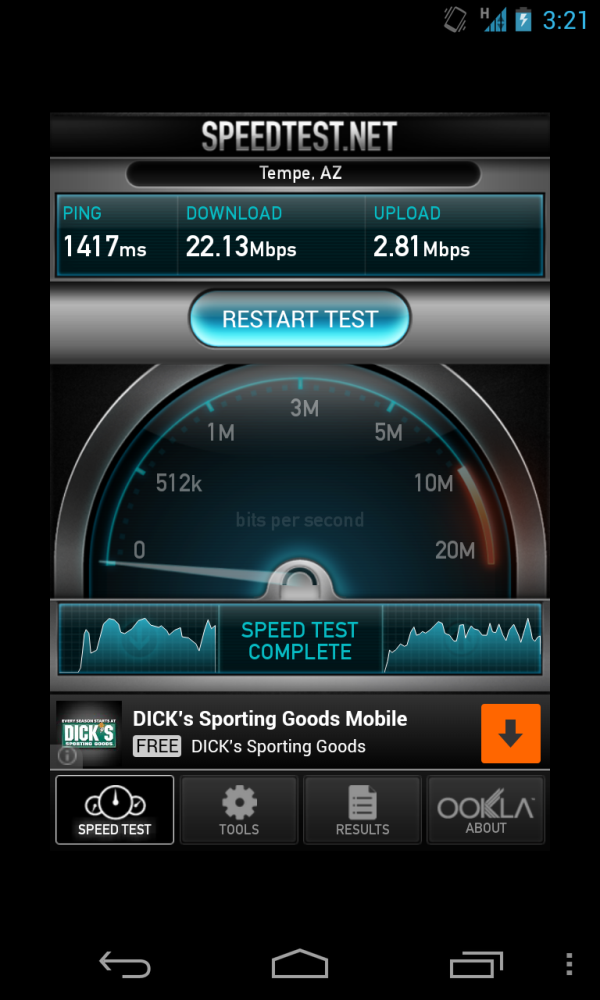Google Nexus 4 and Nexus 10 Performance Preview
by Anand Lal Shimpi & Brian Klug on November 2, 2012 11:00 AM ESTEarlier this week Google announced two new flagship Nexus devices: the Nexus 4 smartphone and the Nexus 10 tablet. We received review samples of both earlier this week, and while we're hard at work at full reviews of the devices we couldn't help but share all of the test data we've been able to amass at this point.
For those who aren't familiar with it, the Nexus 4 features Qualcomm's Snapdragon S4 Pro SoC - a quad-core 28nm Krait CPU with Qualcomm's next-generation Adreno 320 GPU. The combination proved quite formidable in the MDP/T we tested, as well as LG's recently announced Optimus G. The SoC drives a 4.7-inch 1280 x 768 IPS display and is paired with 2GB of LPDDR2 memory. The Nexus 4 ships unlocked with 8GB of NAND for $299 without a contract ($349 for the 16GB version). Pair that with DC-HSPA+ support and you get an absolute killer smartphone for use on T-Mobile: no contracts, very low monthly fees, and compelling cellular performance:
Brian will talk more about the combination in his full review, but rest assured that the lack of LTE is workable depending on T-Mobile coverage where you live/travel to.
The Nexus 10 also boasts a brand new SoC: Samsung's Exynos 5 Dual. The Exynos 5 Dual features two ARM Cortex A15 cores running at 1.7GHz as well as ARM's own Mali-T604 GPU. This happens to be the exact same platform used in the new Chromebook, just running Android. The Nexus 10 features a 10.1-inch 2560 x 1600 display, giving it the same resolution as the 13-inch MacBook Pro with Retina Display - but in an even smaller form factor. Google is also aggressive on Nexus 10 pricing: the 16GB WiFi-only tablet sells for $399, with the 32GB version going for $499.
Both Nexus devices run Android 4.2 and are guaranteed to be the first devices to be updated to upcoming Android revisions for the foreseeable future (it's the power of Nexus).
We haven't had a ton of time to test the devices and put this together so you're going to see combined performance charts throughout the rest of this article.
CPU Performance
The big story when it comes to CPU performance is a look at how the Cortex A15s perform under Android. Unfortunately we're still left with mostly browser based benchmarks to measure CPU performance, which actually highlights a major issue in our testing: Android V8 optimization doesn't seem to be anywhere near as good as it is under Chrome OS or Windows. As a result, all of the Nexus 10 performance scores end up slower than the new Chromebook - despite using the same SoC and running Chrome on both platforms. It's also possible that the Exynos 5 Dual in the Chromebook is allowed to burn a bit more power, translating to better performance, but either way the solution here in the Nexus 10 doesn't look as good across the board.

SunSpider performance is good, but not significantly better than Qualcomm's Krait based Snapdragon S4. Both the iPhone 5 and RAZR i are able to outperform the Nexus 10. The S4 Pro based Nexus 4 tends to be in line with other S4 based devices - SunSpider doesn't really give much credit to the extra 2 cores.

BrowserMark puts the Nexus 10 behind many platforms that should be faster, I'm even wondering here if there's some hard partitioning of memory bandwidth between the CPU and GPU to drive the 2560 x 1600 display that's simply choking the CPU here.
The Nexus 4 does ok, but again there seem to be some V8 optimization issues at work here under Android 4.2. At 1.5GHz it should deliver at least the performance of the dual-core Snapdragon S4 solutions.

Octane is the first test where the Cortex A15s are really able to flex their muscle - the Exynos 5 Dual based Nexus 10 manages to outperform the RAZR i by 34%, and compared to the A6/Swift based iPhone 5 the advantage grows to 64%.
The Nexus 4 performs about in line with other Snapdragon S4 based devices, although once again the extra 2 cores don't seem to be doing much for it here at all.

Kraken also paints the Cortex A15 based Nexus 10 in a good light: there's a 30% advantage over the RAZR i and a 76% advantage over the iPhone 5. These numbers will shrink a bit compared to other tablets, but not by much. The Nexus 4, once again, ends up performing similarly to dual-core Snapdragon S4 based devices.
Overall, the Nexus 10 results show us some real promise for what we can expect from ARM Cortex A15 based SoCs. The potential upside to this new architecture is huge.

















244 Comments
View All Comments
UpSpin - Sunday, November 4, 2012 - link
A phone doesn't know when you don't need this stuff, so you have to tell the phone somehow that you don't need BT at the moment, ...Wifi always has to scan the surrounding to get detected and to detect access points. If it doesn't do this, it won't be able to connect on its own. But scanning consumes battery life.
The same with BT and every other bidirectional wireless technology.
GPS is different and it does go to sleep if no app needs it, but sometimes some apps request GPS even if not necessary. But then it's not the fault of Apple or Google, but the fault of you installing such a poorly written app. Because Apple doesn't allow background tasks and likes to limit the options of the user it's a minor issue on iOS but a bigger on Android, but it's your decision to use or not use such apps.
However, on android you just have to swipe down the status bar to get access to such settings in an instant. Or even better, use NFC tags, so the smartphone knows exactly what profile you like in the car, on your desk, in your office, ...
Or I use a setting/app which automatically turns on Wifi and off the lockscreen if my phone gets charged, because then I'm at home. So I don't have to do it either.
But never phones, thanks to NFC allow more comfortable options just as mentioned.
chippey5 - Wednesday, November 28, 2012 - link
Thanksvision33r - Monday, November 5, 2012 - link
Samsung S3 battery life is worst than the S2 or HTC One X. I switched over to iPhone 5 because the battery life on android is simply atrocious.The only way to stay close to Iphone is to get android with a big battery and increase the weight.
People use phones and they shouldn't require tinkering to be used easily. That's the main problem with Android is that it requires an insane amount of tweaking to use efficiently.
wlmeng11 - Saturday, November 17, 2012 - link
"get android with a big battery"http://source.android.com/source/downloading.html
I didn't see any options for getting a bigger battery here.
Please differentiate between hardware and software.
You can't get iOS with a big battery either.
BrandoHD - Sunday, November 4, 2012 - link
If it's draining that much overnight, then there is something keeping the phone awake, in the land of ANdroid, there are tools that can be used to find the issue and fix it, no need to wait on an update from AppleAs usual, in your effort to try to put blame on the device, it is clear that this is a PEBPAC
Problem Exists Between Phone And Chair - edited for relevancy
:-)
clsid - Friday, November 2, 2012 - link
I have owned Samsung Galaxy devices with poor battery life and compared to the iPhone 4S or the iPhone 5 it is truly an issue. If I get an Android phone it will have to be a Razr Maxx, otherwise an iPhone 5 is the right choice.Fx1 - Saturday, November 3, 2012 - link
iphone 4S wouldnt last from 8am to 8pm without charge. My S3 lasts from 8am to 2am with 15% left. This is with a huge screen and quad core.Dont forget i never charge my phone i just switch out batteries.
kmmatney - Saturday, November 3, 2012 - link
I routinely get 2+ days out of my iPhone 4S...doobydoo - Sunday, November 4, 2012 - link
My gf gets 2 days easily with her 4S.Sounds like you have a faulty battery.
KitsuneKnight - Sunday, November 4, 2012 - link
Similar to what others have said, my 4S also gets 2 days with fairly heavy usage. Hell, today I'd say I had rather light usage (probably only 30 minutes of streaming audio through the internal speaker, and some browsing), I've only dropped down to 92%.